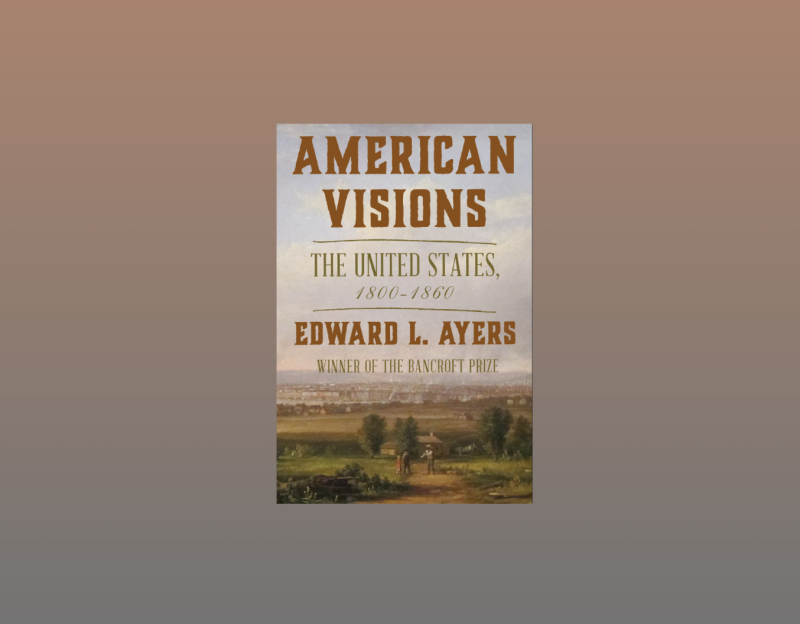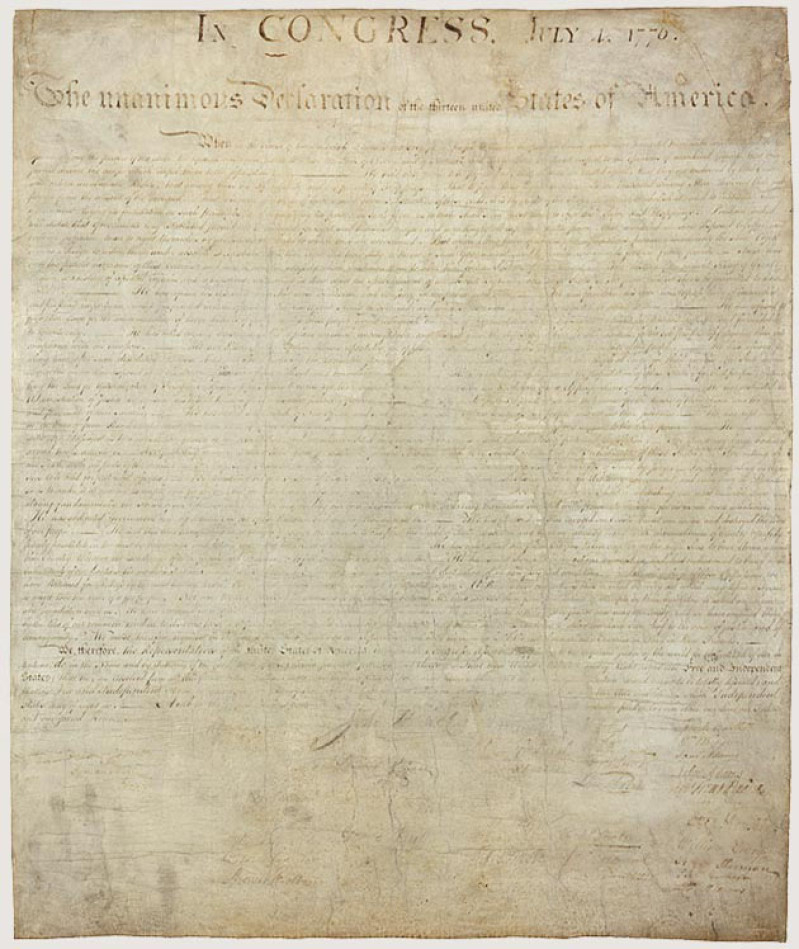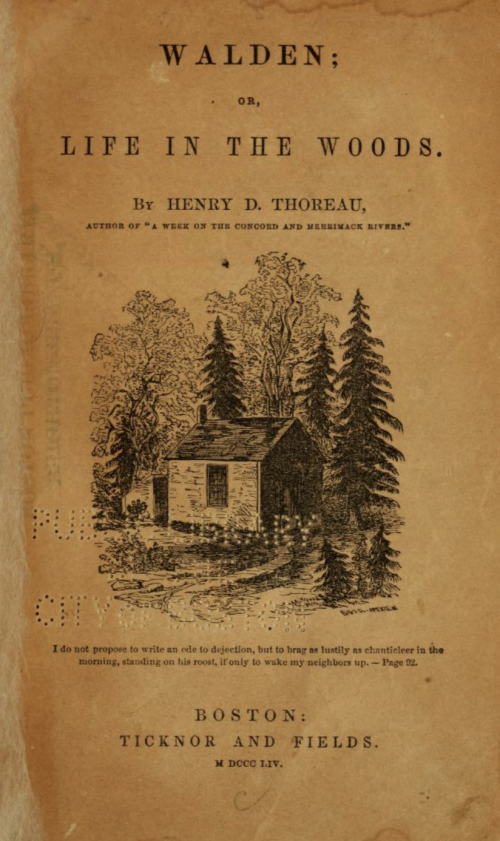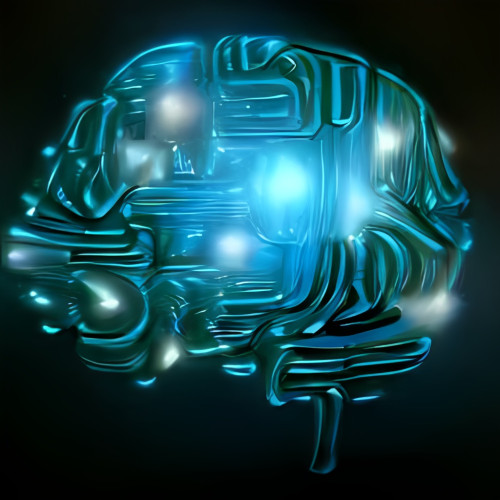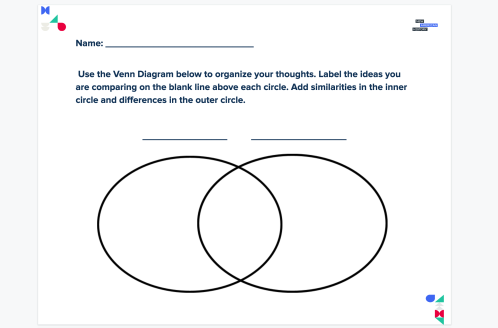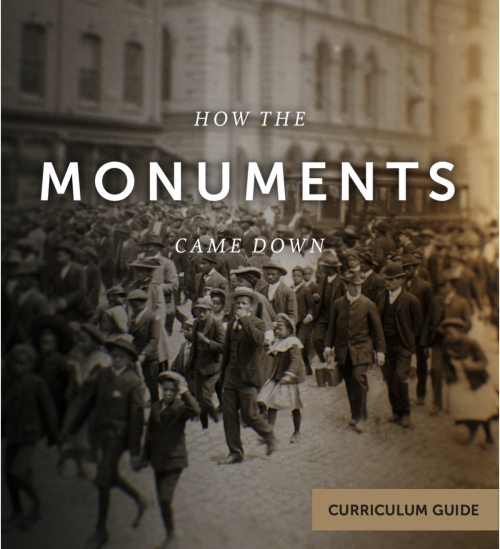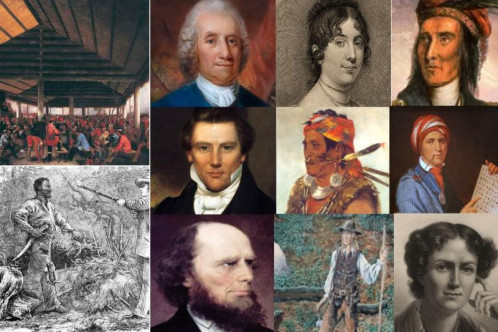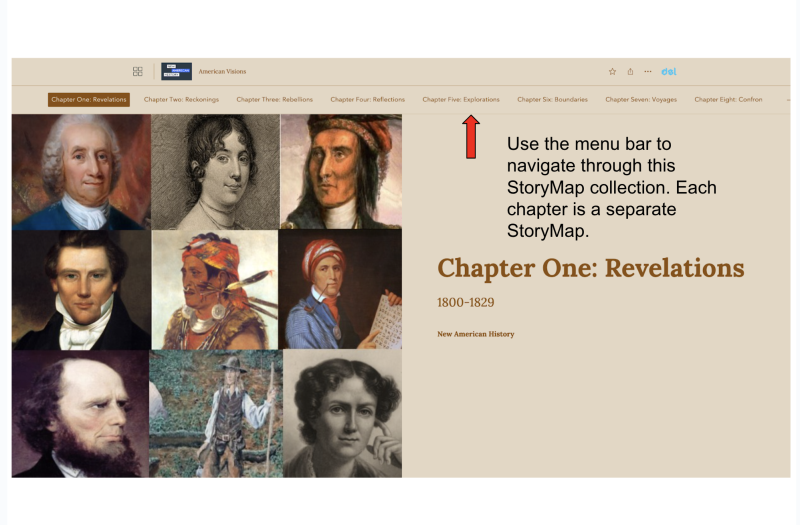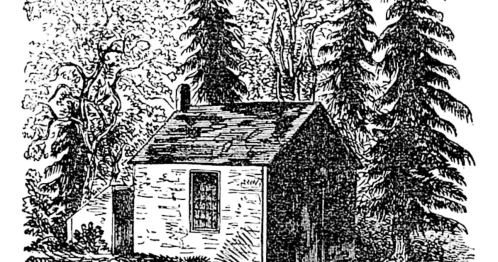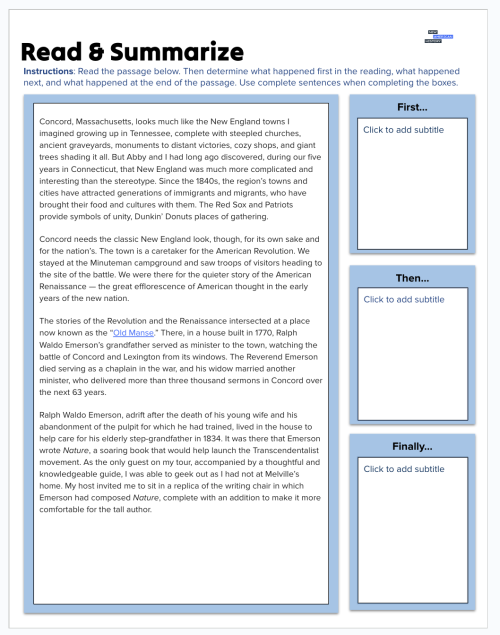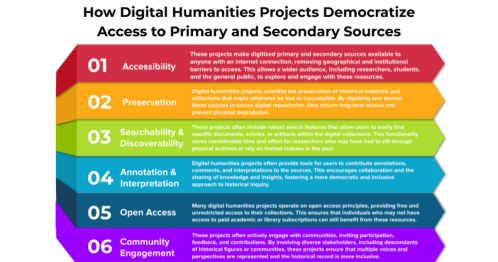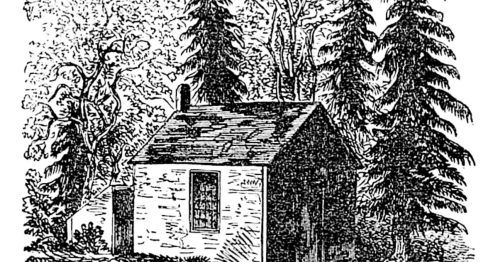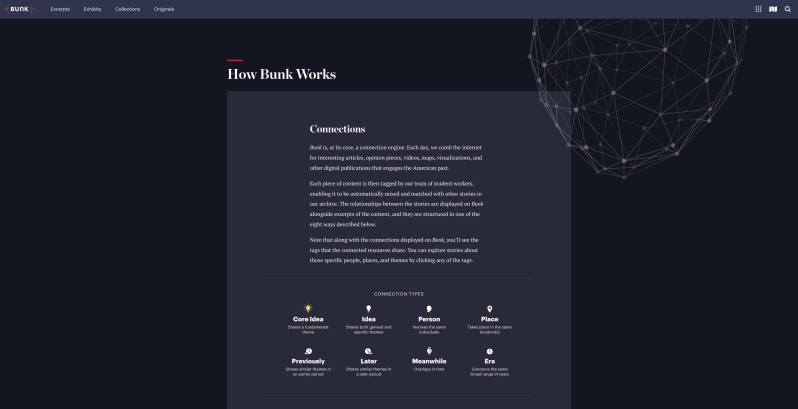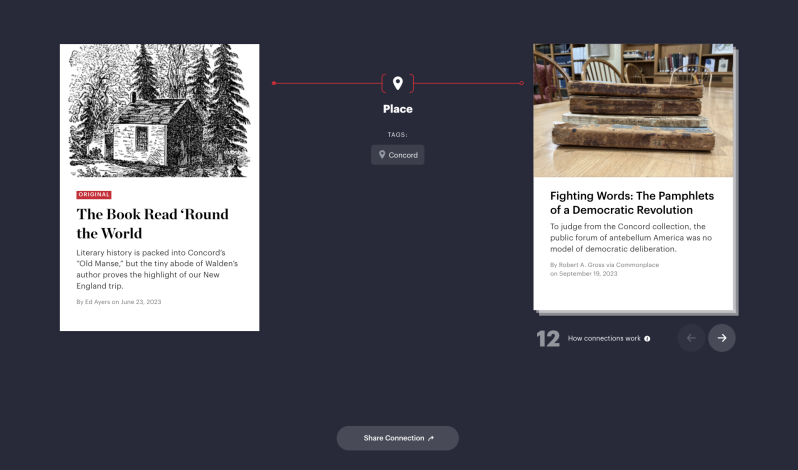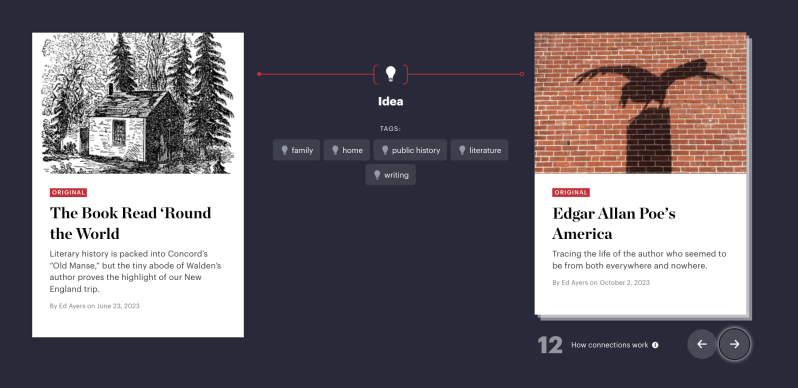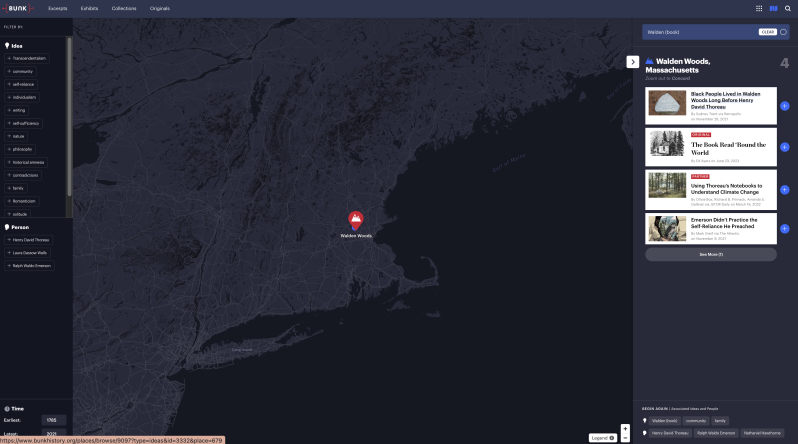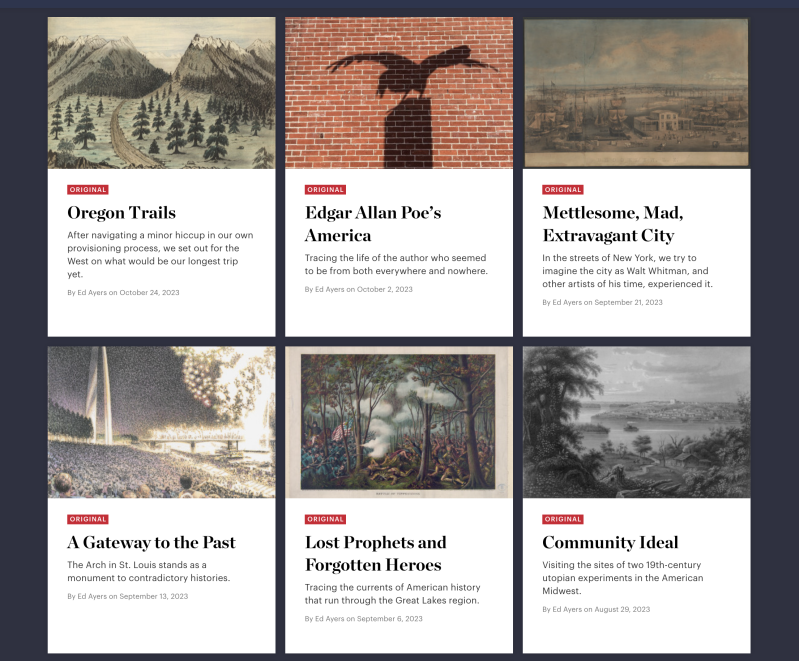This work by New American History is licensed under a Attribution-NonCommercial-ShareAlike 4.0 (CC BY-NC-SA 4.0) International License. Permissions beyond the scope of this license may be available at newamericanhistory.org.
American Visions: Exploring Primary and Secondary Sources Through Walden and Generative AI
View Student Version
Standards
C3 Framework:D1.5: Determining Helpful SourcesD2.His.1: ChronologyD2.His.2: Change and Continuity over TimeD2.His.4: Influencing PerspectivesD2.His.7.9-12: Explain how the perspectives of people in the present shape interpretations of the past.D2.His.8.9-12: Analyze how current interpretations of the past are limited by the extent to which available historical sources represent perspectives of people at the time.D2.His.9: Primary and Secondary SourcesD2.His.13: Use of Primary Sources in Secondary SourcesD2.His.16: Integrating Multiple PerspectivesD2.His.17: Critiquing Secondary Works
National Council for Social Studies:Theme 2: Continuity and Change
AP United States HistorySkill 2: Sourcing and SituationSkill 5 Making Connections
EAD FrameworkTheme: Contemporary Debates & PossibilitiesDesign Challenge: Balancing the Concrete & Abstract
Teacher Tip: Think about what students should be able to KNOW, UNDERSTAND, and DO at the conclusion of this learning experience. A brief exit pass or other formative assessment may be used to assess student understandings. Setting specific learning targets for the appropriate grade level and content area will increase student success.
Suggested Grade Levels: High School (9-12), including APUSH
Suggested Timeframe: 3-4 class periods, 45 minutes in length, or 3 block periods, 90 minutes each.
Suggested Materials: Internet access via laptop, tablet or mobile device
Key Vocabulary
Algorithms - Step-by-step instructions or sets of rules that computers use to solve problems or complete tasks, similar to the way a chef follows a recipe.
Artifact - An object made or used by humans that provides information about the past.
Artificial Intelligence - The development of computer systems capable of performing tasks that typically require human intelligence, such as speech recognition or decision-making.
Commemorate - To honor or remember an important person, event, or achievement.
Context/Contextualize - words that are used with a certain word or phrase that help to explain its meaning, ex. historians provide context or contextualize historical events and documents.
Copyright - A legal term that refers to the exclusive rights given to creators or owners of original creative works. This includes things like books, movies, songs, artwork, and software. Copyright protects the creator's right to control how their work is used, reproduced, distributed, and displayed.
Data - raw information in the form of numbers, text, or other symbols.
Data Talk - Short 5-10 minute classroom discussions to help students develop data literacy. This pedagogical strategy is similar in structure to a number talk, but instead of numbers students are shown a data visualization and asked what interests them.
Democratize - To make an organization more democratic, supporting a system in which all citizens have a voice or a vote. To make something accessible, available, or appealing to everyone.
Digital Humanities - the use of digital tools to study human culture and society with computational methods and technologies
Generative Artificial Intelligence (Generative AI) - A branch of artificial intelligence that involves the creation or generation of new and original content. This technology is designed to mimic human creativity by producing original ideas, artwork, music, or text, among other forms of content. Generative AI algorithms are typically trained on large datasets and are capable of analyzing patterns and trends to then produce new content that resembles the input it has been trained on.
Historical empathy -The ability to understand and relate to the experiences and feelings of people who lived in the past.
Hudson River School - A school of landscape painting in the mid-19th century movement in American art focused on the natural beauty of the Hudson River Valley and surrounding areas. It emerged during a time when the United States was experiencing rapid expansion and industrialization.
Infographic - A visual image such as a chart or diagram used to represent information or data
Material culture -The physical objects, such as tools, clothing, buildings, and art, that are created and used by a particular society or group of people.
Philosophy - The study of fundamental questions about existence, knowledge, values, reason, and more.
Primary source - An original document or artifact created at the time of an event or by a person directly involved, providing firsthand evidence or eyewitness accounts.
Preserve - To protect or maintain something in its original or existing state.
Public Domain - Works that are no longer protected by copyright and are available for anyone to use without permission.
Secondary source - A source that interprets, analyzes, or discusses primary sources, providing an interpretation or analysis of the events or people involved.
Serene - Calm, peaceful, and undisturbed.
Significance - The importance or meaning of something in a particular context.
StoryMap - A tool that combines maps with storytelling, allowing the user to visually showcase a narrative or information related to specific locations.
Travelogue - A written or visual account of a person's experiences, thoughts, and observations while traveling to different places.
Treaty - An official agreement or contract between two or more nations or groups, usually regarding peace, trade, or territory.
Transcendentalism - A philosophical and literary movement in the 19th century that emphasized individual, intuition, and the belief that humans can transcend their limits through spiritual insight.
Read for Understanding
Teacher Tip:
This Learning Resource includes language in the body of the text to help adapt to a variety of educational settings, including remote learning environments, face-to-face instruction, and blended learning.
If you are teaching remotely, consider using videoconferencing to provide opportunities for students to work in partners or small groups. Digital tools such as Google Docs and Google Slides may also be used for collaboration. Rewordify helps make a complex text more accessible for those reading at a lower Lexile level while still providing a greater depth of knowledge.
American Visions: The United States, 1800-1860 by Historian Edward L. Ayers serves as the companion text, however, each component serves as a standalone Open Education Resource (OER). These include content archived in Bunkhistory.org, The Internet Archive, and an ArcGIS Online StoryMap used in this Learning Resource. All leveled reading passages were created using generative artificial intelligence (GenAI) tools for increased accessibility. Students will compare and contrast primary and secondary sources with AI-generated content to explore how this technology may or may not enhance historical thinking as part of the inquiry process.
The First, Then, Finally strategy is used to help students summarize the reading excerpts and reflect then discuss their thinking. A Google Slides template is provided, or you may print paper copies as needed. An Infographic is provided as both an image and Google Slide for students to build background knowledge on the digital humanities, using primary and secondary sources. Additional resources are included on Public Domain Day and accessing content in the public domain in this blog post.
Students will engage in a brief Data Talk using Bunk and Bunk Places. Data talks are short classroom discussions to help students develop data literacy. This pedagogical strategy is similar in structure to a number talk, but instead of numbers students are shown a data visualization and asked what interests them. A simple set of questions including “What do you notice?” or “What questions do you have?” can help students improve their data literacy skills across multiple content areas, including the humanities.
This Learning Resource follows a variation of the 5Es instructional model, and each section may be taught as a separate learning experience, or as part of a sequence of learning experiences. We provide each of our Learning Resources in multiple formats, including web-based and as an editable Google Doc for educators to teach and adapt selected learning experiences as they best suit the needs of your students and local curriculum. You may also wish to embed or remix them into a playlist for students working remotely or independently.
For Students:
The sixty years between 1800 and 1860 saw the politics, religion, language, literature, art, population, and economy of the young United States change with remarkable speed, forever shaping American history. You will explore primary and secondary sources using a variety of digital humanities tools and resources to gain a better understanding of 19th-century America.
Engage:
How do historians use both primary and secondary sources to interpret the past?
Historians rely on both primary and secondary sources to interpret the past. Primary sources are firsthand accounts by people, or evidence from the time period being studied, while secondary sources are interpretations or analyses of primary sources by historians or scholars. Secondary sources can also involve the synthesis or evaluation of primary sources. They often attempt to describe or explain primary sources.
A primary source is one that was created at the time of the events or conditions being studied, by someone who directly witnessed or experienced them. Primary sources include diaries, journals, autobiographies, images, and personal letters. Historians use these to understand the thoughts, experiences, and emotions of individuals in the past. For example, reading Anne Frank's diaries provides insights into the daily life of a young Jewish girl during the Holocaust.
Official documents including government records, treaties, laws, or court cases are also primary sources. These provide insights into political decisions, legal processes, and power struggles. The United States Declaration of Independence is a primary source that, alongside contemporary sources, helps analyze the motivations and ideals behind the American Revolution. Earlier drafts and correspondence related to the final document also give us context into the time period and mindsets of the authors.
Artifacts, objects, and other material culture such as pottery, coins, clothing, weapons, furniture, and buildings or ruins from a particular time period are primary sources that provide material evidence of the past. These are often shared through museums and historical sites, with interpretations from public historians and museum curators.
Paintings, sculptures, photographs, and other forms of artwork represent the artistic styles, religious beliefs, and cultural values of a particular era. Exploring the works of landscape painters from the Hudson River School helps us understand the artistic techniques, cultural themes, and historical context of the period.
Henry David Thoreau's Walden is a primary source because it relates his personal experiences and observations during his two-year stay in a small cabin next to Walden Pond in the mid-19th century. Thoreau's writing provides first-hand accounts of his thoughts, reflections, and interactions with nature, society, and himself, and deepens our understanding of his experiences and ideas during that time period.
Use the Internet Archive to access this text, now in the public domain. Take a few minutes to explore this platform, and familiarize yourself with the search tools, visual adjustments, and audio features.
Now navigate to page 98 and read (and/or listen to) an excerpt from Walden. Read along from pages 98-100. Your teacher may allow you to read with a partner, or independently.
- According to the text, what was Henry David Thoreau’s motivation for spending time at Walden Pond?
- What does the document suggest about progress?
- What is the role of the workers mentioned in the document?
- What are some potential benefits of living a simple life and being connected to nature, according to the text?
- How can we apply Thoreau's belief in living simply and being connected to nature in our daily lives?
Now read a modified version of the same excerpt, created by a Generative AI site, rewritten in simpler language. You may also use the Immersive Reader app located in the top right corner of the screen to access an audio version of this excerpt.
Turn and talk to a partner, comparing and contrasting between the original version and the computer-generated version. Your teacher may give you a paper copy or allow you to access this Venn diagram to record your thoughts.
- Did you or your partner have a preference between the two versions?
- Did the audio versions enhance your understanding of the excerpts?
- Would you have preferred to have read a paper version? If so, why?
- How did the AI-generated version change the content or author’s voice?
- Which version do you think best represents the historical content? Why?
Select one or two keywords or phrases from the original text of Walden, and search for them using the “Search inside” feature located on the top left side of the Internet Archive screen.
Take a few minutes to explore other paragraphs in the book using the keywords or phrases you and your partner selected.
- What do you notice?
- What questions do you still have about Walden?
- Where might you look to find the answers to these questions?
In the United States, most works of literature, both fiction and nonfiction, enter the public domain 70 years after the author’s death. Public domain material may be accessed, reproduced, and modified without breaking any copyright laws. This varies somewhat in the United States and in other countries.
Some libraries around the world celebrate “Public Domain Day” each year, often on January 1st, announcing classic titles about to come into the public domain. In recent years, early versions of Winnie the Pooh, Sherlock Holmes, and The Great Gatsby have come into the public domain.
Walden has been in the public domain since 1954. For more about Walden and the public domain, read this blog about The Public Domain Project.
- What is one book you are most interested in reading from the list of books now in the public domain?
- How might releasing these into the public domain benefit readers?
- What creative ideas do you have for using literature in the public domain?
Your teacher may ask you to record your answers on an exit ticket.
Explore:
In what ways do secondary sources enhance our understanding and appreciation for the past?
Secondary sources include a wide variety of types of sources. For academic work, these include textbooks and scholarly articles written by college professors and other trained experts. These sources compile and analyze information from multiple primary sources. For example, students might use a high school history textbook to understand the causes and consequences of World War II. Other sources could be a document or recording that talks about, or summarizes, information originally presented elsewhere. Secondary sources help us interpret primary sources, sometimes assigning value to them and/or helping us draw conclusions about what was reported in primary sources.
Biographies are books that explore the lives of individuals, drawing from primary and secondary sources. A biography of Martin Luther King Jr. can provide insight into his contributions to the Civil Rights Movement and its impact on American society.
Documentaries and historical films, while not written sources, can be considered secondary sources when they interpret events based on primary sources. For example, watching the documentary "How the Monuments Came Down" can provide a different perspective on the debates surrounding the removal of Confederate monuments and memorials in public spaces by combining interviews and archival footage.
By combining primary and secondary sources historians gain a more comprehensive understanding of the past. Primary sources provide direct access to the time period or event, while secondary sources offer interpretations and analyses from multiple perspectives. It is by critically analyzing these sources that historians can construct a multi-layered and well-rounded interpretation of history.
An example, American Visions: The United States, 1800-1850, examines the sixty years between 1800 and 1860 as the politics, religion, language, literature, art, population, and economy of the young United States changed with remarkable speed, forever shaping American history. To help see the variety and depth of those changes, a collection of secondary sources includes a StoryMap collection offering a geographic and chronological map of the era, connecting to helpful websites, as well as a Travelogue series published in multiple formats that explores current places where history happened and continues to happen. It presents portraits and images of people who confronted the challenges and opportunities of these critical decades of American history. The stories of those people and of this time are explored in the book that inspired this project: American Visions: The United States, 1800-1860, by historian Ed Ayers.
Take a few minutes to explore the StoryMap collection landing page, and select the “Get started” button. Read the introduction, then select a chapter to explore from the menu bar across the top of the screen. Scroll down and notice how images, text, and links to both primary and secondary sources are included in the StoryMap. Select a few of these for further investigation.
- How is the StoryMap organized?
- What elements of the StoryMap did you find most interesting?
- What surprised you?
- What questions do you have about the StoryMap?
Now navigate back to the StoryMap landing page and select Chapter 9. Take a few minutes to explore this section of the StoryMap, and locate the section focusing on author Henry David Thoreau.
- What primary and secondary sources do you see included in this section?
- What other topics or authors are included in this section?
- How does this content enhance your understanding of Thoreau and the excerpt of Walden you read earlier?
Historian Ed Ayers spent over two years researching, studying, and traveling to the places he writes about in American Visions, sharing his adventures and insights in the form of a Travelogue series, American Journey. Ed’s stories from the road, traveling with his wife Abby in their RV, “Bertha,” are published on multiple platforms including Medium and in Bunk.
Read an excerpt from the series, The Book Read Round the World, as linked into the StoryMap from Bunk.
Take some time to read the Travelogue entry again, Using the “First, Then, Finally” strategy to summarize your thoughts about the text.
Your teacher may provide a paper copy, or you may make a digital copy of the slides and edit them to capture your thinking. Your teacher will provide directions on how they would prefer you to complete your work.
Your teacher may ask you to record your answers on an exit ticket.
Explain:
In what ways do digital humanities projects like Bunk and the Internet Archive democratize access to primary and secondary sources?
Digital humanities projects like Bunk and the Internet Archive democratize access to primary and secondary sources in several ways. (Access this Infographic as a Google Slide.)
Review the StoryMap and Travelogue excerpts again, noting examples of ways each one includes one or more of the examples included in the Infographic.
Turn and talk to a partner about ways you might engage with public humanities resources across other content areas, including science, English, or the arts.
Using the Travelogue piece you read earlier, explore the connections to the piece in Bunk, looking for evidence of how digital humanities projects like Bunkhistory.org and the Internet Archive democratize access to primary and secondary sources by making them widely accessible, preserving historical materials, enabling easy search and discovery, fostering collaboration, promoting open access, and engaging communities in the process.
Use the image gallery above to help you navigate Bunk. The blue arrows on the sides of each image allow you to scroll through these slides. Share one or more connections you found illustrating one of these concepts using the “Share Connection” button below each connection. Note: New content is added to Bunk daily, causing these connections to change and update. The results of a search may not match from day to day.
Return to the original excerpt on Walden from the Travelogue series. Try changing the type of connection to another icon, such as Idea, Place, etc., and explore the related tags. What topics do you notice related to the digital humanities?
Note your search choices, including Walden the book, and Walden Woods, a place in Massachusetts.
Explore both the book and the location in Massachusetts to see other related content connected in Bunk.
Turn and talk to an elbow partner. Each of you will have 3-5 minutes to engage in a brief Data Talk, about the way data is visualized on Bunk to enhance your understanding of what you have read and learned so far about Walden.
- What do you notice?
- What questions do you have?
- How is Walden, the text, related to Walden Woods, the geographic location?
- What was the most interesting or surprising connection you observed between these using Bunk or Bunk Places?
Your teacher may ask you to record your answers on an exit ticket.
Elaborate:
What lessons might we learn by studying Thoreau and other writers, artists, or thinkers from this era?
Quotes provide an opportunity for us to analyze Thoreau's perspective on the historical context of his time and consider the relevance of his ideas in the present day. Select one of the following quotes from Walden to analyze and annotate using SketchQuotes.
"I went to the woods because I wished to live deliberately, to front only the essential facts of life, and see if I could not learn what it had to teach, and not, when I came to die discover that I had not lived.”
“I wanted to live deep and suck out all the marrow of life, to live so sturdily and Spartan-like as to put to rout all that was not life, to cut a broad swath and shave close, to drive life into a corner, and reduce it to its lowest terms.”
“Our life is frittered away by detail. An honest man has hardly need to count more than his ten fingers, or in extreme cases, he may add his ten toes, and lump the rest. Simplicity, simplicity, simplicity!”
Publicly share your work, either on display at school or at a community event, or perhaps allow a teacher or trusted adult to share via social media without any identifying information included. Please email your finished piece to: editor@newamericanhistory.org! We’d love to see your work!
Your teacher may ask you to record your answers on an exit ticket.
Extend:
Where and how is local history interpreted in your community?
In his Travelogue series American Journey, historian Ed Ayers emphasizes the significance of visiting public spaces like museums and historical sites. Ayers argues that these spaces are not only repositories of artifacts and information, but they serve as essential platforms for engaging with history and understanding the complexities of the American experience.
Throughout his writings, Ayers emphasizes the power of encountering physical locations where significant events occurred. He argues that sites like battlefields, plantations, and museums provide a tangible connection to the past, allowing visitors to develop a deeper understanding and appreciation for the historical context of these places.
The Travelogue series highlights the educational value of museums and historical sites. Ayers suggests that they offer a unique opportunity for individuals to expand their knowledge beyond what textbooks or lectures can provide. Through immersive experiences, visitors can engage with interactive exhibits, view authentic artifacts, and even participate in reenactments, thus creating a more meaningful and memorable learning experience.
Ayers also stresses the importance of public spaces as democratizing forces. He contends that these spaces provide access to history for people from all walks of life, fostering a sense of collective memory and shared understanding. By visiting museums and historical sites, individuals are encouraged to explore diverse perspectives and challenge existing narratives, ultimately contributing to a more inclusive and comprehensive understanding of American history.
Using the Travelogue series as a model, create your own travel essay for a historic site in your own community or one you have recently visited or remembered. Think about the ways Professor Ayers described not only the physical landscape but also the cultural landscape of each location he visited in his travels: people, cultures, ideas, art, languages, etc. Add images, hyperlinks, and text as needed. Consider sharing your essays aloud in class in pairs, small groups, or as a whole-class discussion or read-aloud. Your teacher may decide to publish your essay along with others from your classmates into a digital or printed Travelogue project of your own. We would welcome a chance to read what you created. Your teacher may post a link to social media and tag us, or email us at: editor@newamericanhistory.org.
Your teacher may ask you to record your answers on an exit ticket.
Citations:
Avery, Kevin J. “The Hudson River School: Essay: The Metropolitan Museum of Art: Heilbrunn Timeline of Art History.” The Met’s Heilbrunn Timeline of Art History, October 1, 2004. https://www.metmuseum.org/toah/hd/hurs/hd_hurs.htm.
Ayers, Ed. “American Journey.” Bunk, May 17, 2022. https://www.bunkhistory.org/resources/the-discovery-of-america.
Ayers, Ed. “American Journey.” Medium, May 17, 2022. https://medium.com/new-american-history/the-discovery-of-america-c5e4f4dfa867.
Ayers, Ed. “History on the Road.” Bunk, May 17, 2022. https://www.bunkhistory.org/resources/history-on-the-road.
Ayers, Ed. “The Book Read ’Round the World.” Bunk, June 23, 2023. https://www.bunkhistory.org/resources/the-book-read-round-the-world.
ChatGPT, response to “Rewrite the text provided for an 8th-grade reading level and young adult audience,” OpenAI, September 4, 2023.
“Data Talks Archives.” YouCubed, 2023. https://www.youcubed.org/resource/data-talks/#:~:text=Data%20talks%20are%20short%205,and%20asked%20what%20interests%20them.
Lawton, George. “What Is Generative AI? Everything You Need to Know.” Enterprise AI, October 3, 2023. https://www.techtarget.com/searchenterpriseai/definition/generative-AI.
“Places.” Bunk, 2023. https://www.bunkhistory.org/places/.
Shrum, Rebecca. “Material Culture .” The Inclusive Historian’s Handbook, June 3, 2019. https://inclusivehistorian.com/material-culture/.
Thoreau, Henry David. “Walden; or, Life in the Woods : Thoreau, Henry David, 1817-1862 : Free Download, Borrow, and Streaming.” Internet Archive, January 1854. https://archive.org/details/waldenorlifeinwo1854thor/page/98/mode/2up.
Thoreau, Henry David. “Walden, Chapter 1: Economy : Henry David Thoreau : Free Download, Borrow, and Streaming.” Internet Archive, May 30, 2015. https://archive.org/details/podcast_grade-10-summer-audiobook-samp_walden-chapter-1-economy_1000343546016.
“United States History 1 (OS Collection).” Lumen. Accessed September 22, 2023. https://courses.lumenlearning.com/suny-tc3-ushistory1os/chapter/primary-source-henry-david-thoreau-reflects-on-nature-1854/.
VandeCreek, Drew. “‘Webs of Significance’: The Abraham Lincoln Historical Digitization Project, New Technology, and the Democratization of History.” DHQ: Digital Humanities Quarterly: Webs of Significance: The Abraham Lincoln Historical Digitization Project, New Technology, and the Democratization of History, 2007. https://www.digitalhumanities.org/dhq/vol/1/1/000003/000003.html.
The writings of Henry D. Thoreau. Accessed September 22, 2023. https://thoreau.library.ucsb.edu/thoreau_walden.html.
View this Learning Resource as a Google Doc


